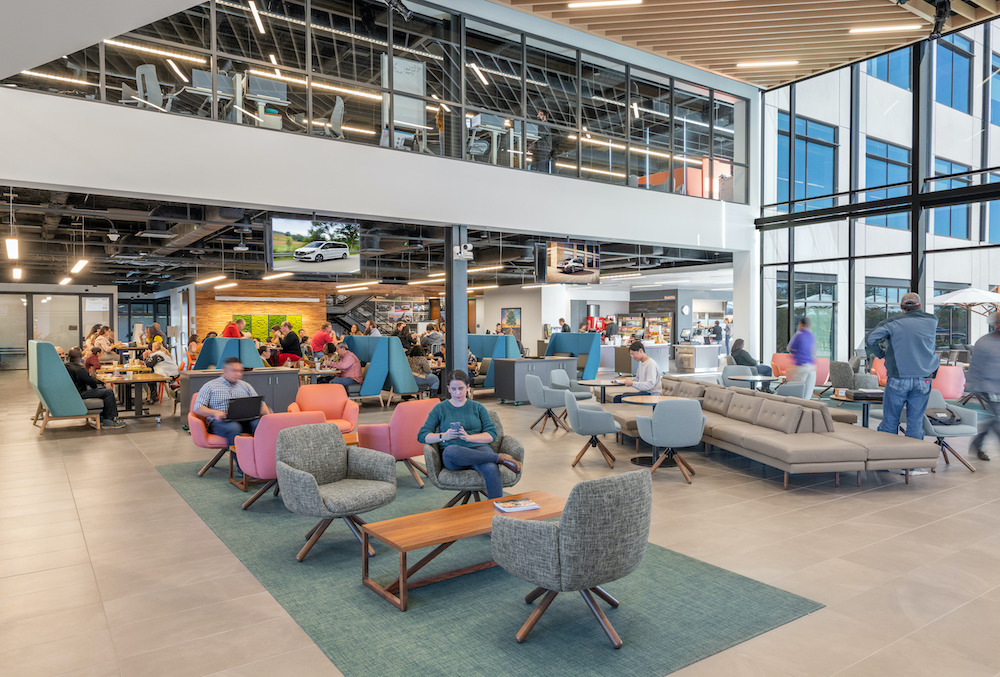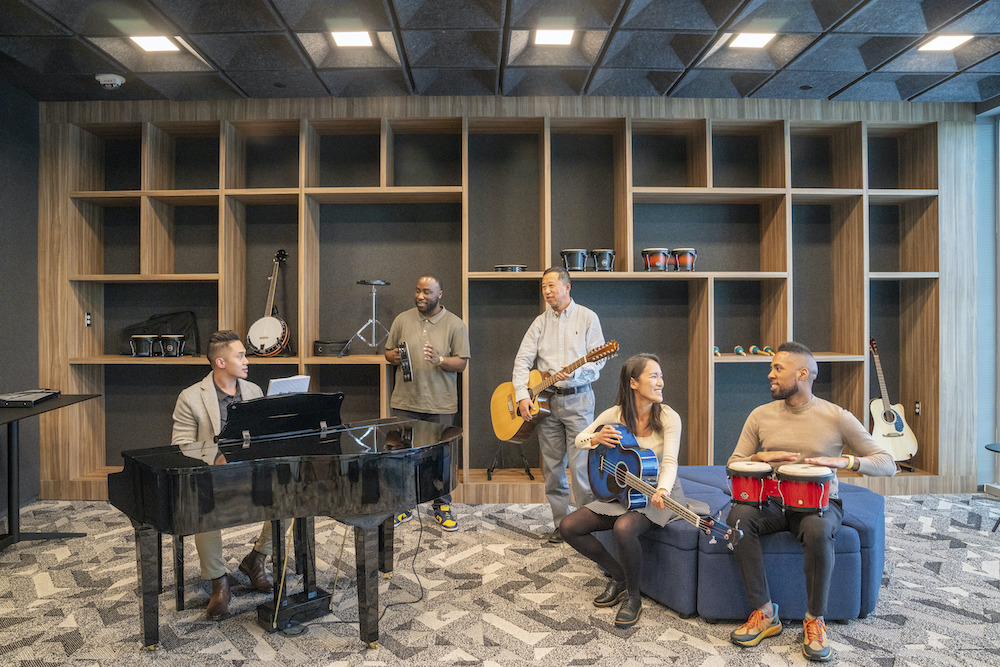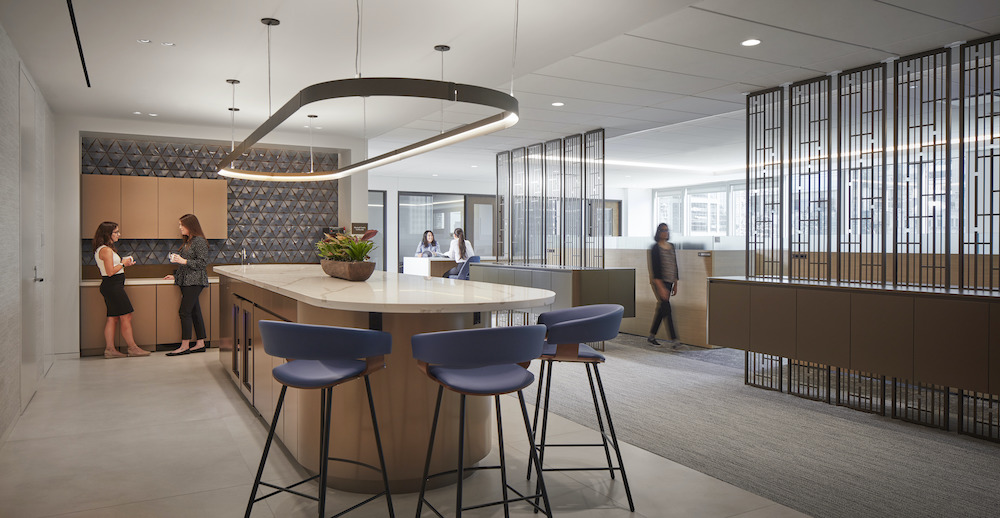- The time invested in a daily commute is now a significant factor in selecting our work location. For many, the decision to commute to an office comes down to whether the benefits of being in the office outweigh the costs and inconveniences.
- With so many factors to consider, the key to making a trip to the office enticing and commute-worthy lies in improving the employee experience.
- A successful workplace today requires more than just creating a cool looking physical space; it’s about establishing an ecosystem that fosters connections, offers flexibility, and creates an environment where people are genuinely excited to come to work.
This article was written by SmithGroup’s Matt Dumich for Work Design Magazine.
Despite headlines about large corporations’ back-to-the-office mandates, work patterns have normalized. With the holidays behind us, data indicates that office occupancy numbers have remained relatively stable. Like many organizations, SmithGroup and its clients across industries are embracing hybrid work models with employees balancing time between an office and working remotely. According to a recent Gartner study, 51% of U.S. knowledge workers will be hybrid and 20% will be fully remote as of the end of 2023. This shift is changing our daily patterns and is having a transformational impact on people, real estate, and our cities.
Allowing employees the flexibility to choose from a variety of work environments supports improved work/life integration, yet also invites individuals to reconsider the value proposition for how they spend the precious few hours in a given day. The time invested in a daily commute is now a significant factor in selecting our work location. For many, the decision to commute to an office comes down to whether the benefits of being in the office outweigh the costs and inconveniences. Factors such as weather, traffic, parking costs, and the reliability and safety of public transportation influence this decision, as do efficiency, workstyle preferences and personal (after-hours) obligations.

Image courtesy of SmithGroup
With so many factors to consider, the key to making a trip to the office enticing and commute-worthy lies in improving the employee experience. A successful workplace today requires more than just creating a cool looking physical space; it’s about establishing an ecosystem that fosters connections, offers flexibility, and creates an environment where people are genuinely excited to come to work. Many individuals yearn for social interaction and authentic experiences, finding energy in the presence of colleagues, even when not directly collaborating. As a result, organizations are going to great lengths to transform offices into dynamic, amenity-rich hubs for social interaction, cultural engagement, and team building. Enhanced space types include tech-rich collaboration areas and community-centered spaces. Ultimately, it’s all about people connecting both within and beyond the workplace.
A successful work ecosystem recognizes the importance of providing a variety of environments and choices for employees to work most effectively. This approach takes into consideration the diverse needs and preferences of the workforce, promoting productivity, creativity, and overall wellbeing. SmithGroup is exploring opportunities to reimagine workplace environments, elevating them from strategic renovation projects to more significant investments in new, higher quality space.

Image courtesy of SmithGroup
While each organization is unique, some considerations to enhance the workplace experience include:
Informal Spaces for Team Bonding
A dynamic workplace includes informal spaces designed to foster team bonding. These areas are a place to connect with the community and culture of an organization, separate from traditional focus and collaboration zones. They promote social cohesion, team building, and the strengthening of professional relationships. These spaces may be used for causal, social, and team-building events to open mic and karaoke sessions, which encourage a sense of community and shared purpose.
Effective Teamwork and Hybrid Collaboration
Workplaces provide a variety of formal and informal spaces to support teams and enhance collaboration. These areas should be adaptable to a range of functions that support creativity and innovation from brainstorming sessions to formal presentations. They also need to balance the “buzz” and vibrancy that gives a space energy, with acoustic privacy for hybrid meetings. This ensures that teams can seamlessly communicate, share ideas, and achieve their goals in a productive and inclusive environment.
Individual Work with Flexibility
A successful workplace ecosystem recognizes the importance of effective individual work. It provides access to a range of spaces that accommodate the different work modes and styles of employees including secluded spaces for intense focus work balances with comfortable spaces for respite with a connection to outdoors. The design is influenced by remote work from home environments in an attempt to “de-office the office.”
Our evolving work patterns also extend their influence beyond individual workplaces and have a profound impact on cities. Fewer people working in the office every day impacts local businesses that rely on office workers as customers. Neighborhoods like Fulton Market in Chicago and South Lake Union in Seattle that combine residential, commercial, and recreational uses are more vibrant, resilient, and better equipped to adapt to change. Location is another factor impacting the overall employee workplace experience. The vibrancy of a neighborhood is a key amenity as employees seek coffee, lunch, or happy hour; mobility options (from electric scooters to public transportation); and access to parks or walking paths.

Image courtesy of SmithGroup
Now that flexible work arrangements have become the norm, the question of whether the workplace experience is “commute-worthy” takes center stage. As the workforce navigates a landscape of hybrid and remote work models, the calculus for daily commutes has evolved. The decision to travel to the office hinges on a delicate balance between the advantages of in-person collaboration and the inconveniences of commuting. Many factors play a role in this decision-making process but, what truly tips the scale in favor of a commute is the quality of the employee experience.
The workplace is no longer just a functional physical space; it has transformed into an ecosystem designed to foster connections, offer flexibility, and create an environment that genuinely excites employees. It’s about the allure of social interaction, authentic experiences, and the energy derived from the presence of colleagues. Organizations are investing in dynamic, amenity-rich offices that prioritize social interaction, cultural engagement, and team building. By offering diverse work environments and choices, organizations not only promote productivity and creativity but also cater to the diverse needs and preferences of their workforce and ultimately enhance overall wellbeing. This shift in workplace dynamics also extends its influence beyond office walls, revitalizing neighborhoods and redefining the concept of a commute-worthy destination. In embracing these concepts, organizations unlock the full potential of their workforce and foster a culture of innovation.


 Dr. Gleb Tsipursky – The Office Whisperer
Dr. Gleb Tsipursky – The Office Whisperer Nirit Cohen – WorkFutures
Nirit Cohen – WorkFutures Angela Howard – Culture Expert
Angela Howard – Culture Expert Drew Jones – Design & Innovation
Drew Jones – Design & Innovation Jonathan Price – CRE & Flex Expert
Jonathan Price – CRE & Flex Expert













